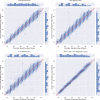Machine learning for accurate estimation of fetal gestational age based on ultrasound images
- PMID: 36894653
- PMCID: PMC9998590
- DOI: 10.1038/s41746-023-00774-2
Machine learning for accurate estimation of fetal gestational age based on ultrasound images
Abstract
Accurate estimation of gestational age is an essential component of good obstetric care and informs clinical decision-making throughout pregnancy. As the date of the last menstrual period is often unknown or uncertain, ultrasound measurement of fetal size is currently the best method for estimating gestational age. The calculation assumes an average fetal size at each gestational age. The method is accurate in the first trimester, but less so in the second and third trimesters as growth deviates from the average and variation in fetal size increases. Consequently, fetal ultrasound late in pregnancy has a wide margin of error of at least ±2 weeks' gestation. Here, we utilise state-of-the-art machine learning methods to estimate gestational age using only image analysis of standard ultrasound planes, without any measurement information. The machine learning model is based on ultrasound images from two independent datasets: one for training and internal validation, and another for external validation. During validation, the model was blinded to the ground truth of gestational age (based on a reliable last menstrual period date and confirmatory first-trimester fetal crown rump length). We show that this approach compensates for increases in size variation and is even accurate in cases of intrauterine growth restriction. Our best machine-learning based model estimates gestational age with a mean absolute error of 3.0 (95% CI, 2.9-3.2) and 4.3 (95% CI, 4.1-4.5) days in the second and third trimesters, respectively, which outperforms current ultrasound-based clinical biometry at these gestational ages. Our method for dating the pregnancy in the second and third trimesters is, therefore, more accurate than published methods.
© 2023. The Author(s).
Conflict of interest statement
J.A.N. and A.T.P. are Senior Scientific Advisors of Intelligent Ultrasound Ltd. All other authors declare that they have no competing interests or other interests that might be perceived to influence the results and/or discussion reported in this paper.
Figures






References
-
- March of Dimes, P., Save the Children. WHO. Born Too Soon The Global Action Report on Preterm Birth (eds Howson, C. P., Kinney, M. V. & Lawn, J. E.) (World Health Organization, Geneva, 2012).
-
- W. H. O. Alliance for Maternal Newborn Health Improvement Late Pregnancy Dating Study Group. Performance of late pregnancy biometry for gestational age dating in low-income and middle-income countries: a prospective, multicountry, population-based cohort study from the WHO Alliance for Maternal and Newborn Health Improvement (AMANHI) Study Group. Lancet Glob. Health. 2020;8:e545–e554. doi: 10.1016/S2214-109X(20)30034-6. - DOI - PMC - PubMed
LinkOut - more resources
Full Text Sources
Research Materials

